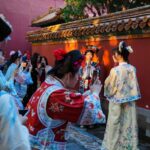I am an art enthusiast living in a small town and enjoy watching cultural performances. However, to see high-quality shows, I often have to travel to the county seat or even big cities. Are there any policies to promote more high-quality performances and cultural resources in local communities?
The Decision of the Third Plenary Session of the 20th Central Committee proposed “establishing a mechanism for delivering high-quality cultural resources directly to local communities.” This year’s Government Work Report stated: “Improve the public cultural service system and promote the delivery of high-quality cultural resources to local communities.”
“We aim to bring a continuous stream of quality performances to local communities, ensuring the public enjoys rich cultural experiences.” A representative from the Public Culture Services Department of the Ministry of Culture and Tourism said, “We will continue to advance the standardization and equalization of urban and rural public cultural services, enabling residents to better participate in cultural activities, develop artistic skills, enjoy cultural life, and strengthen their spiritual well-being.”
— Improving the public cultural service network at the grassroots level.
“Attending night school to learn art and make friends,” “Borrowing books, watching performances, and enjoying village galas without leaving the village”—these are just some of the praises from people across different regions. Guided by policies such as the “Guidance on Promoting the Centralized-Branch System of County Cultural Centers and Libraries,” local governments are advancing the construction of centralized-branch systems for county cultural centers and libraries, integrating scattered and independent resources into an organized framework. High-quality performances, books, and other resources are continuously delivered to communities and villages, transforming “single-source supply” into “diversified and interactive supply.”
The representative from the Public Culture Services Department stated: “We will further strengthen the construction of county-level cultural centers and libraries, enabling shared book borrowing and returning, digital services, coordinated cultural activities, and unified staff training. We will enhance the role of cultural centers in promoting social values and integrate them with the New Era Civilization Practice Centers. Additionally, we will extend operating hours, support late-night services, and encourage nighttime cultural activities. We will also promote public cultural activities such as square dancing, seasonal village galas, and village songs.”
— Innovating and expanding urban and rural public cultural spaces.
Visiting urban reading rooms and rural book houses for enriching cultural experiences has become a habit for many. The Ministry of Culture and Tourism, the National Development and Reform Commission, and the Ministry of Finance jointly issued the “Opinions on Promoting High-Quality Development of Public Cultural Services,” outlining plans for new public cultural spaces.
Public cultural spaces are flexibly integrated into various daily settings. In urban streets, commercial districts, and cultural parks, new public spaces combine book reading, art exhibitions, cultural salons, and light dining. In rural areas, cultural halls, plazas, and village stages are popular among residents.
“To date, over 40,000 new public cultural spaces have been built nationwide,” the representative said. “In May this year, the ‘Opinions on Continuously Promoting Urban Renewal Actions’ issued by the central authorities proposed scientifically planning new public cultural spaces. We support local efforts to create distinctive and high-quality public cultural spaces, expand coverage, and enhance effectiveness to meet the growing demand for high-quality cultural life among urban and rural residents.”
— Accelerating the digitalization of public cultural services.
In recent years, adapting to digital trends, “cloud-based” public cultural services have allowed urban and rural residents to share digital cultural products such as performances, lectures, and online art courses. In Ningbo, Zhejiang, borrowing books is convenient even on remote islands. In Changsha, Hunan, online cultural services like square dance tutorials have gained widespread popularity. The National Public Culture Cloud platform enables live streaming, event participation, and skill learning with just a click.
The representative added: “Next, we will strengthen the development of smart library systems and enhance the digital services of cultural centers. We will explore public-friendly digital cultural experience spaces and integrate new formats like digital art into public venues, ensuring seamless and engaging online and offline cultural services.”



